The application of dental veneers is a process where front visible part of the teeth is modified and replaced with a thin layer of porcelain masking stains with a newer lighter shade and correcting misaligned crowded teeth simultaneously. Dental veneers can transform the most crowded and stained teeth to the most beautiful and dazzling smile within a couple of weeks.
Ultra-Thin Dental Veneers (Thin, Micro-Thin)
Micro thin or ultra-thin dental veneers offer the most stunning look and durability of any other type of dental veneer. Because they are so thin, they allow a significant amount of natural light to transmit through the tooth which translates to a life-like beautiful perfect and dazzling smile. The process of fabrication of these veneers allows the lab technicians to add multiple tones and shades within the veneers allowing for superior customization of color to capture the beauty of naturally stunning teeth.
Pros and cons of thin, micro-thin, or ultra-thin veneers:
Pros:
- Stunning life - like results
- Minimal tooth structure removal “0.3-1mm”
- Preserving the maximum amount of natural tooth
- Remarkable durability and strength
- Great ability to customize shade and color
Cons:
- May not be appropriate for teeth with deep stains
- May not be appropriate for teeth with significant loss of tooth structure
- Not appropriate for teeth with existing large fillings and/or cavities
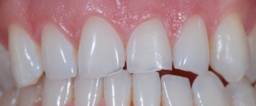
Ultra-Thin Veneers Before
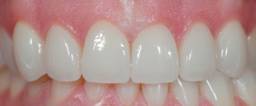
Ultra-Thin Veneers After
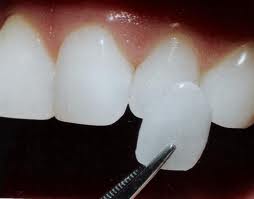
Ultra Thin Veneer Applied to Tooth
Traditional Dental Veneers
The main difference between traditional dental veneers and ultra-thin dental veneers is that the traditional veneers are thicker and allow for greater ability of masking deep stain and altering significant misalignment of teeth. There is also a difference in how these veneers are fabricated by lab technicians. Traditional dental veneers give the lab technician the ability to layer the porcelain while press porcelain techniques are mostly utilized with ultra-thin veneers.
Traditional dental veneers, depending on the type or brand of porcelain used, are also known as:
- PS Empress Veneers
- E.Max Veneers
- Conventional porcelain veneers
Pros and cons of traditional dental veneers
Pros:
- Excellent strength and durability
- Excellent for teeth with deep stains or replacing other defective conventional veneers
- May work on teeth with some decay and/or fillings
Cons:
- Requires removal of more tooth structure than thin veneers
- Traditional dental veneers can look less natural than thin veneers due to the thicker porcelain which blocks light transmission. This ultimately translates to a less life-like appearance.

Emax Dental Veneers Before

Emax Dental Veneers After
Emax Dental veneers by Dr. Saleh “Try-In Before Bonding”
No-Prep Dental Veneers
Pros and cons of no-prep dental veneers: Lumineers, Vivaneers and DURAthin
Pros:
- No structure removal required
- Very good durability and strength
- No anesthesia needed in some cases
Cons:
- Monotone look with minimal translucency
- No ability to customize shade and color within the veneer
- May lead to over-contouring teeth causing them to look bulbous or rounded
- Risk of altering bite and the way teeth come together
- Poor margin “where tooth meets veneer” adaptation
- May cause gingival “gum” inflammation
Direct composite veneers (resin veneers)
Direct composite veneers (resin veneers) are considered the lost art in cosmetic dentistry as they are utilized less and less by cosmetic dentists. These veneers are made out of composite resin similar to the material used in white fillings. Generally these veneers are fabricated and bonded by the dentist on the same day.
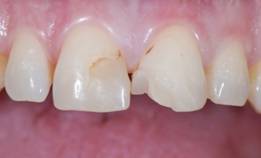
Direct Composite Veneer Before
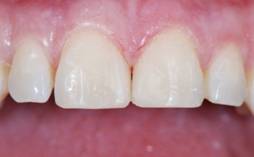
Direct Composite Veneer After
Direct Composite Veneers by Dr Saleh
Pros and cons of direct composite dental veneers (resin veneers):
Pros:
- Less costly than other types of veneers
- Immediate same day results
Cons:
- May discolor overtime
- Most technique sensitive of any type of dental veneers
- Limited ability of masking deep stains
- Varying results depending on the artistic and technical skill of the cosmetic dentist
Dr Saleh’s Thoughts on the Various Types of Dental Veneers
Minimal prep dental veneers, in my opinion, offer the best combination of stunning life-like aesthetics along with conserving tooth structure and good marginal adaptation.
No-prep dental veneers sound good in theory, however, adding more structure to a tooth that doesn´t need it will interfere with the biological adaptation of surrounding gums to teeth and can potentially cause more problems in the long run. Therefore, No-prep dental veneers work best for front teeth with spaces or teeth that are already deficient in tooth structure. Traditional veneers have minimal indications at present, however, IPS EMax Veneers in that category are currently the most popular and they can look beautiful.
What you need to be aware of when considering dental veneers?
Dental veneers and bite mechanics
How your teeth come together when you bite (bite mechanics) presents one of the most determining factors as to whether or not you are veneer candidates. Bite mechanics is also one of the most over-looked and neglected causes of dental veneer fracture, breakage, continuous deboning and ultimate failure. Veneers are not meant to withstand significant direct and lateral biting forces. These limitations are usually discussed during your cosmetic dental complimentary consultation. When bite challenges are present, usually modified prep dental veneers, partial coverage crowns and even full coverage crowns are considered. Modified dental veneers, partial coverage crowns and full coverage crowns can all be made from the same types of veneer materials discussed earlier.
Bonding process of dental veneers
The bonding process of dental veneers to teeth is very technique sensitive. In addition there are several methods of bonding porcelain to teeth. Utilizing the bonding method that results in the strongest most durable outcome is extremely important.
Experience in placing dental veneers is very important
Dental experience plays a very important role in the long term success of dental veneers. Experience with dental veneers also plays a vital role in producing a unique, beautiful, customized, dynamic and harmonious smile in line with the rest of the facial features of patients seeking cosmetic dental veneers. Experienced dentists understand that the following factors are crucial to the long term success of dental veneers:
- Meticulous understanding of bite mechanics is extremely vital in dental veneers. Unfavorable bite mechanics is one of the most common causes of veneers breakage, separation and failure.
- Knowledge of various types of porcelain veneers “outlined above” and specific indications is equally important.
- Finally, a deep understanding of The Golden Rule of Proportions and its role in smile makeover and cosmetic dentistry construction is an absolute must.
Consequently, experience coincides with success of dental veneers and longevity. At Dental Dynamics in Portland, Oregon, perfect results are not negotiable. This is one of the reasons we set ourselves apart by offering a five year replacement warranty on dental implants and all fixed restorations, including dental veneers, dental crowns, and dental bridges. The only requirement is to maintain your regular cleanings and exams.